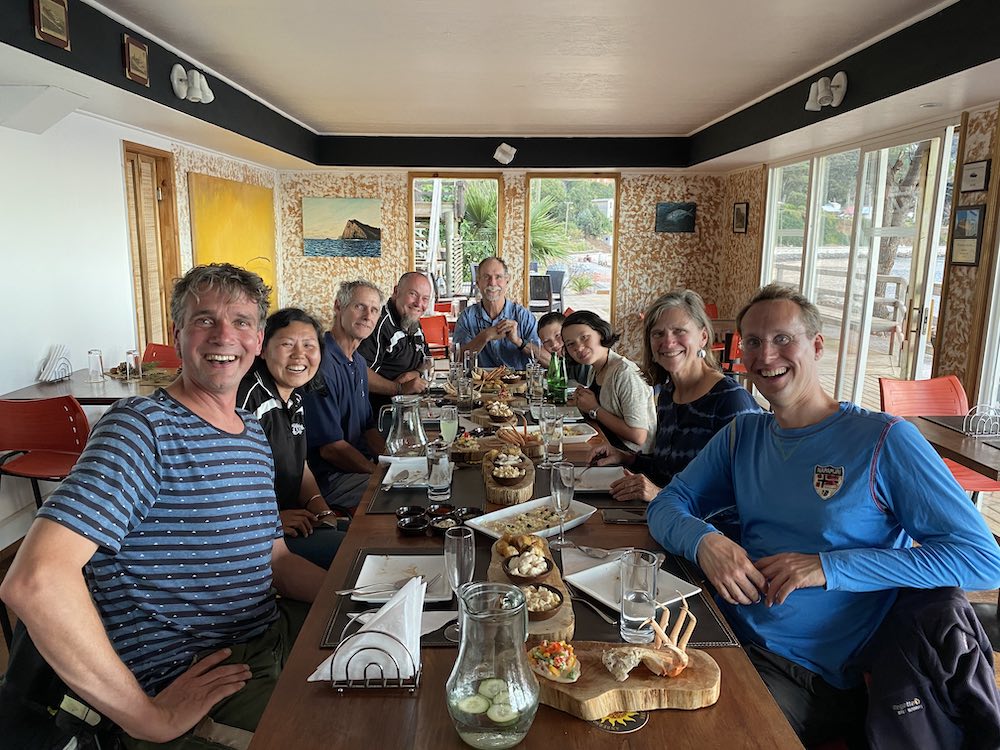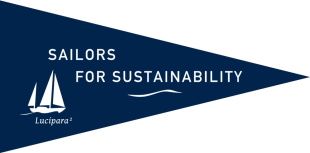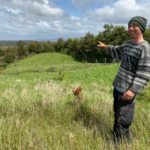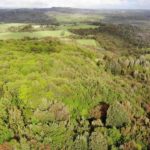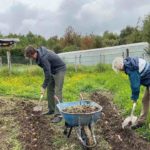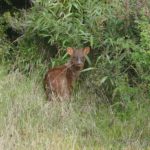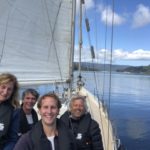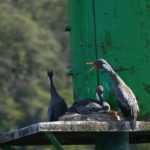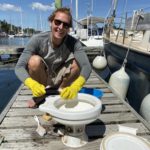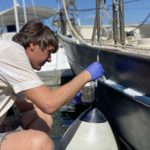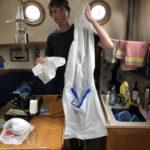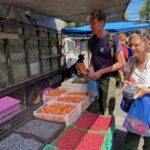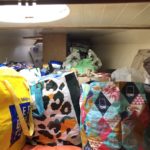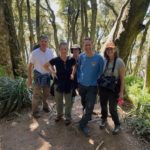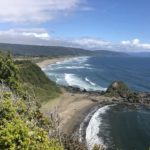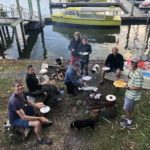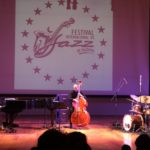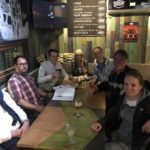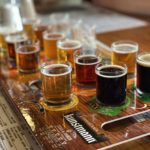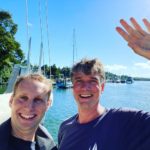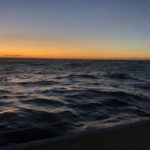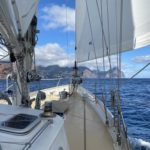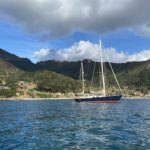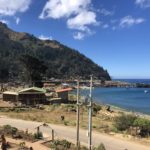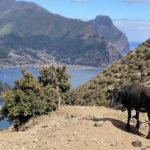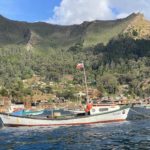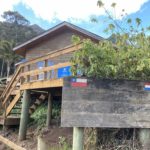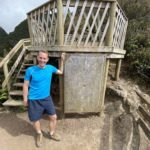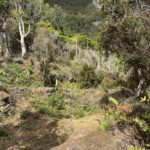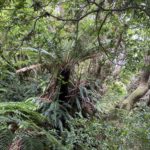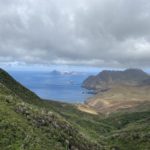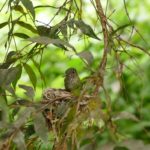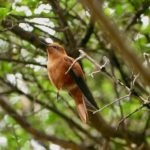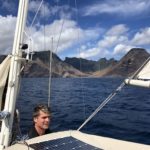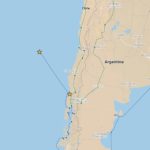
Together with guests we visit a nature restoration farm, before preparing our boat for the Pacific. We celebrate Christmas on a remarkable island.
Valdivia – Isla Robinson Crusoe (CHL)
“It’s so green!” Joke marvels at the dense vegetation on the way between the airport and the marina. She and Meint have just arrived in Valdivia and are excited to spend a week with us. It’s the prize they won when renewable energy company Vandebron promoted our mission last year. Now it’s our job to give them an idea of what it’s like to be on a sailing trip around the world in search of sustainable solutions. So, naturally, sailing and documenting a sustainable project are on the program. “If you like green, you’re in luck”, Floris jokes. Coincidentally, trees figure prominently in the reforestation initiative we have arranged to visit with them.
A Farm that Restores Nature
We take them to a family farm on the island of Chiloé. At “Alihuen”, meaning big tree, we check into the cabaña reciclada. The comfortable cottage is made of recycled materials, such as wood from a demolished building. Our host is the Belgian Jeroen Beuckels. He describes how the island must have been completely forested once. As more people settled, more and more trees were felled for building, heating, and to make way grassland.
Over the past 15 years, Jeroen has planted more than 23,000 trees to turn grassland into forest. “In addition, I estimate that around 100,000 trees have reproduced themselves. They not only regulate water levels, but are also the habitat for many native insects, birds and a rare deer, the pudú”, Jeroen says.
Next to Beuckels’ home are a small field, a vegetable garden, and a greenhouse. We all help him with planting potatoes. The plot of land used for agriculture is enough to feed the family. That’s possible because the Beuckels family does not consume much dairy and meat. “That saves a lot of space”, Jeroen explains.
On a tour of the property we notice how remarkably dense the forest is. Where grass once grew, we see moist, carbon-rich forest soil. When we pass a clearing, Joke suddenly comes to a halt. “Look left”, she gestures. At the edge of the forest we spot a stocky brown deer. “A pudú!”, we whisper with big smiles on our faces. Jeroen’s approach is clearly successful. Find out more about this inspiring family farm at our sustainable solution story and video about Alihuen
A Taste of Sailing
It’s fitting that we are doing a story about trees, we won’t see them for a long time when we cross the Pacific. To give Joke and Meint a taste of what that’s like, we take them sailing down the Valdivia river to where it reaches the ocean. It’s the first sunny day of the week, there is a very light breeze, and the current is just right. We float peacefully down the river and get close ups of red-footed cormorants sitting on buoys feeding their young. Just past the town of Niebla, Meint’s excitement grows as he feels the rhythmic ocean swell lift Lucipara 2 up. “So this is what it feels like? I love it!” he grins. “It’s not always this gentle”, we assure him, but we’re happy conditions are so favourable today. When we move to an anchorage to have lunch, black-necked swans surround us to complete the picture-perfect setting.
The week with Joke and Meint flies by and before we know it, we have to say goodbye to them. We could not have asked for better guests and the boat feels a bit empty without them around. Back on our own, there’s no more getting around it: we have work to do. Lucipara 2 yearns for some TLC, we have some articles to write and videos to make, and we need to stock up on food, lots of it.
Workshop Central
Steel Lucipara 2 gives us confidence out at sea, but right now, her hull material gives us pain. There are rust spots all over the deck. If we don’t treat them, they will only get bigger and can eventually lead to holes. So over the course of four days, Floris sands them down until he sees the shining metal underneath. He then degreases the areas and paints over them, layer by layer. The hull needs touch ups, too, so Ivar does the same on the outside to give Lucipara 2 her blue look back. We also re-mount our toilet, install a new GPS antenna and replace a stay that was showing the first signs of wear and tear. There’s enough work on our to-do list to keep us busy for a few weeks.
The fact that we’re not alone makes it all more bearable. Around us, the crews of SY Eastern Stream, SY Vera, SY Stormalong, SY, Ithaca, and SY Pazzo are also busy working on their boats and preparing for the Pacific. As everyone longs for diversion from the chores, we use every opportunity to have BBQs together, go on hikes, and check out the local jazz festival. Besides good company, they are also great helpers. Jaap fills our gas bottles and dive tank, while Linette shows us how to make a wind catcher. “I can’t wait for that to come in handy”, Floris comments, his mind already on warm Pacific nights.
All of us venture into town numerous times to buy as much groceries as our boats can fit. “How much flour do you think we’ll need in the coming 10 months?” Ivar wonders. “How much of everything, really?” We have heard that doing groceries in the Pacific is both a challenging and expensive affair, so we get as much as possible in Valdivia’s many grocery stores and markets. Our large backpacks accompany us on every trip to town until every compartment of the boat and the entire front cabin is filled with food. “Do you think we have enough until we reach New Zealand?” Ivar wonders. “If not, we just have to go on a diet”, Floris jokes.
Work Some, Play Some
It’s not just work, work, work. In-between our Pacific preparations, we meet Charlotte Lovengreen, the honorary consul of the Netherlands. Her apartment in Valdivia also functions as the Dutch consulate, so it is full of Dutch artefacts, including a biscuit box with a drawing of Amsterdam. But it’s really Charlotte’s hospitality and personality that make us feel at home. Over tea we discuss modern day Chile and the challenges the country faces at the moment.
A few days later we meet her again, this time with a delegation from the Netherlands. Over dinner and beer tasting we learn from Jaap Stuiver about Bluecon. It’s a mobile sewage treatment plant the size of a sea container, ideal for small villages. We will keep an eye on its implementation, which will have great benefits for nature, water, and health!
Soon after we have ticked off all the items of our to-do-list, a good weather window opens up to sail on. There is time for two more farewell dinners, one at the traditional German brewery Kunstmann cervezeria and one onboard SY Vera, where Britta serves a delicious pasta dish. Yet the next morning there is no more procrastination: now it’s our turn to loosen the ropes and wave back to the remaining crews on the pontoon. With the ebb flow we leave Valdivia. Off to the Pacific!
Peaceful Pacific?
Apart from a short trip from Puerto Montt to Valdivia, we have not done any serious ocean sailing in more than six months. How will it feel? A fresh breeze and swell greet us at the mouth of the Valdivia river as if to say: Welcome back, did you miss us? Not really, it turns out. Both of us need some time to adjust during the first day.
On the positive side, the fresh and stable breeze allows us to sail the 450 nautical miles to Isla Robinson Crusoe in only three days. By the time we get used to the ocean’s cadence, endless blue vistas, and being away from civilization, the contours of the famous island appear on the horizon. Brown and green cliffs rise straight out of the water and form a chain of steep mountains. The island looks inhospitable, but on the northside, Cumberland Bay gives some protection from the prevailing south-easterly winds. It’s also where the island’s only settlement is and where our friends of SY Ithaca and SY Pazzo are anchored.
Christmas Banquets
We are just in time before SY Pazzo’s crew Cindy, Willy and John sail on. As an early Christmas gift, Willy invites both SY Ithaca’s crew – Ping, Pierre, their kids – and us for dinner at a restaurant that other sailors highly recommended, Refugio Náutico. We get a taste of the rich seafood cuisine, including the local lobster for which the island is famous. What a treat!
The feast continues on Christmas Day aboard SY Ithaca. In a true display of Chinese-South African hospitality, Ping and Pierre serve one delicacy after another. “You must try this!” they insist with every course. And how can we resist, when they are all so tasty. We spend a wonderful evening together. Sadly, it’s also a farewell dinner, as they are heading in a different direction. It’s an inevitable part of cruising life, unfortunately, to part from friends.
